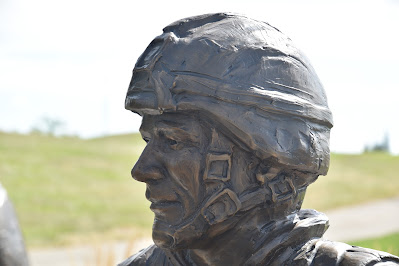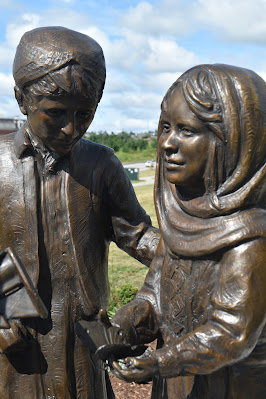
Location: Huron County N 43.90272 W -81.51005
At the corner of Belfast Road and St. Helens Line, beside the community centre.


St. Helens is a quiet rural crossroads in the heart of a Mennonite farming community.
This memorial is best described from the following article in the Signal Star, written by David Yates and published in August 2020.
"On Nov. 11, 1918, John Joynt, a wealthy Huron County farmer and
entrepreneur, was lying in a Buffalo, New York hospital recovering from
the Spanish influenza when he awoke to bells ringing and horns blowing. He knew that the noise heralded news that the War To End All Wars had arrived.
Joynt was born
in Mayo County, Ireland in November 1854. He was the oldest of eight
children born to John and Ellen Joynt, Irish Protestants who immigrated
to Canada about 1865.
After initially settling in Durham County,
the Joynt family removed to West Wawanosh where they were well
established by the 1881 census.
John Jr. married Annie Amelia
Fulford of Teeswater in September 1882 and together they had four
daughters. Joynt went into farming but as a bright and ambitious young
man he branched out into potash production, apple growing and operated
apple evaporator plants in Lucknow, Teeswater and Walkerton.
With
a lucrative trade in exporting hardwoods and fruit, Joynt had risen
from his impoverished background to become a truly self-made man.
By
1919 when Joynt was elected to the provincial legislature as the
Conservative member in North Huron, he owned 1,400 acres of land and was
one of the most prosperous men in the county.
Too old to serve
in the war and having only daughters, Joynt wanted “to do something for
the boys of Huron,” according to the Goderich Star.
At his own
expense, he spent the then-considerable sum of $5,000 on a monument to
honour those from West Wawanosh who had served in the Great War.
The Joynt War Memorial was the only cenotaph in Huron County paid for entirely by a private individual.
He
chose the St. Helens crossroads to erect a monument because whenever he
returned to St. Helens “he always thought of his mother and her
inspiration and he considered this [St. Helens] the most suitable place
for the erection of a monument in appreciation of the deeds of others,”
the Star reported.
Indeed, in 1922, Joynt had donated the site
and moved the St. Helens community centre to the northeast corner of the
crossroads where he intended to place the war memorial.
On May
24, 1923, Victoria Day, “all roads led to St, Helens,” according to the
Wingham Advance. Between 3,000 and 4,000 people gathered for the
unveiling ceremony of Joynt’s memorial. It was the largest gathering
ever held before or since at St. Helens. The impressive ceremony began
with a platoon of Great War veterans marching to the flag-draped
monument halting and firing three volleys into the air followed by a
bugler sounding the “Last Post” before a crowd of thousands who doffed
their caps.
Lieut-Colonel H B Combe, former commander of the
161st Huron Battalion, drew the Union Jack off of the black granite
monument revealing the names of the West Wawanosh men who had served in
the Great War.
Seven “little girls in white” placed floral
bouquets on the monument. Each bouquet represented the name of a West
Wawanosh soldier who fell in battle. For those in attendance who knew
fallen, the cenotaph’s unveiling ceremony was a proxy funeral for those
who lie buried in a foreign grave.
Some idea of the tremendous impact that the Great War had on remote
and rural areas like West Wawanosh is that 87 names of local men are
engraved on the monument of those who wore their country’s uniform.
Local
historian Rhea Hamilton Seeger notes that further research has turned
up even more West Wawanosh names not listed on the monument.
Immediately
after Joynt formally handed the monument over to West Wawanosh, Reeve B
S Naylor, Lieut-Colonel Dougall Carmichael, a highly-decorated war
hero, lauded the valour of Canadians in the Great War calling them “the
finest body of fighting men who ever lived.”
Carmichael remarked
that the “monuments scattered throughout the country help us bear in
mind all the sacrifices, all the sorrows” and, further, hoped “we would
never fail to appreciate what these great men did.”
After the
speeches, appropriate music was provided by the Lucknow Pipe Band,
Lucknow Boy Scouts Band and the Wingham Brass Band. The program closed
with over 3,000 voices singing “God Save the King.”
The Women’s
Institute who had done so much in supporting the local war effort
accomplished the near impossible by providing sandwiches and lemonade
for the multitudes.
The Advance disclosed that 600 loaves of bread were purchased for the occasion and that “every person was fed.”
Undoubtedly, the Joynt Memorial’s unveiling was the profoundly solemn spectacle in West Wawanosh’s history.
Yet,
there were those who criticized the Joynt Memorial as a cynical
political ploy to help buy votes. The Wingham Advance defended Joynt by
observing that “judging by the crowd of people present at the unveiling
we think the people who appreciate Mr Joynt’s philanthropy are very much
in the majority.”
Six more names were added after the Second World War.
After
the demolition of the St. Helens United Church in 1978, a bell with the
names of men who had fought and died in the Great War was placed beside
the monument notes the township history book Reflections of West
Wowanosh (1995).
After serving two terms in the provincial
legislature, John Joynt declined to run for re-election in 1926. He died
in December 1937.
He was eulogized as one who had “achieved high standing in his community and his integrity, not less than his business acumen.”
The
West Wawanosh Soldiers’ Monument, also known as the Joynt Memorial,
eternally bears witness to the courage of a small community at the St.
Helens crossroads."



Marker text:
Cenotaph Front:
JOYNT MEMORIAL
THIS MONUMENT IS ERECTED
IN LOVING MEMORY OF
THE GALLANT HEROES FROM
WAWANOSH TOWNSHIP WHO
OFFERED THEIR LIVES FOR THE
DOMINION OF CANADA AND THE
BRITISH EMPIRE IN THE GREAT WAR
OVERSEAS
*AGAR GEORGE
AGAR STANLEY
ADAMS THOMAS
ALISTON REV. W.C.
ARMSTRONG THOMAS
AGAR IRWIN
*BAKER JAMES
BUCHANAN ROBERT
BERRY JOHN
CASE BENSON
CASE HOWARD
CRANSTON EARL
*COOK SAMUEL
CAMERON CALLUM
CRAIG ERNEST
DURNIN WILLIAM
DONOVAN JOHN
*ERRINGTON FRED
*FINELON JAMES
GLENN FRANK O.
1914 - 1918


Right side:
OVERSEAS
FORAN ELMER
GWYN DAVID
HIBBENS GEORGE
HEADLEY NICHOLAS
HUNKINS A.
HALLAM GEORGE
HUTCHINSON JOHN
HUBBS BERT
IVERS W.A.
JEFFERSON JOHN
JONES SAMUEL
JEFFERSON GORDON
*KENNEDY JOHN
KENNEDY DUNCAN
KING RUSSELL
LAIDLAW ROBERT
*LAWSON HERBERT
LAWSON OLIVER
*LAVIS ARTHUR
LAVIS JAMES
LAIDLAW HERBERT
MEDD ROY
MOORE ROBERT
MURRAY ROSS
MILLS CHARLES
McDONALD CLARENCE
McDONALD WILMER


Left side:
OVERSEAS
McGUIRE ROBERT
NEWMAN ARTHUR
NEVINS CHARLES
NEIL ERNEST
ORSER FRANK
ORCHARD CECIL
PATTERSON JAMES
PATTERSON ARCHIE
PENTLAND HAROLD G.
PLOWMAN THOMAS
RUTLEDGE GORDON
RIVERS BERT
ROBERTSON ROBERTS
ROLLINSON ALFRED
SPROUL HAROLD L.
STALKER ROY
STALKER JOHN
STUART JOSEPH
SYMINGTON CLARENCE H.
SMYLE WILLIAM
TAYLOR JOHN
THOMPSON JOSEPH
THOMPSON ERNEST
WILSON WILLIAM H.
WILSON EARL
WILSON ROBERT


Back:
IN TRAINING IN CANADA
PHILLIPS ROBERT
JEFFERSON CHARLES
THOMPSON JOHN R.
JOHNSTON VICTOR
SMYTH WILLIAM J.
MONK WESLEY
ANDERSON JARVIS
ANDERSON LINFIELD
DURNIN JOHN
WEBSTER ELLWELL
NEWMAN FRED
WELLWOOD JOHN
SOMERVILLE ROBERT
IN GRATEFUL TRIBUTE
2ND WORLD WAR
1939 - 1945
BOWERS WILLIAM
HOUSTON JAMES
IRWIN HAROLD
MAGOFFIN IVAN
McQUILLAN GEORGE
MONTGOMERY ROBERT


Bell Front:
MENEELY & CO., WATERVLIET, N.Y. 1919
IN LOVING MEMORY OF THOSE WHO FOUGHT
AND THOSE WHO DIED FOR FREEDOM
1914 1918
EARL CRANSTON SAM JONES
ARTHUR LAVIS JOHN BERRY
M.C. CAMERON JOHN TAYLOR
ROBT. McQUIRE J.R. STUART
R. ROSS MURRAY JAS. D. BAKER
R.D. BUCHANAN JAMES LAVIS
R.H. ROBINSON ROBT. J. WOODS
Back:
TO JAMES AITCHESON , SR.
IN APPRECIATION OF HIS
EFFORTS AND ZEAL, THIS
BELL WAS ERECTED 1919.































































